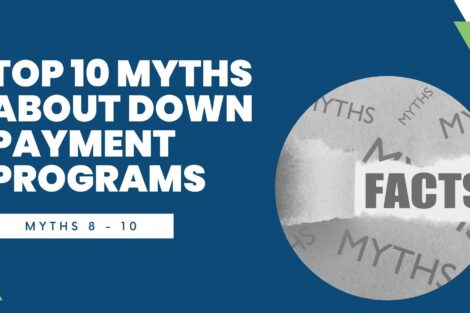
Final 3 Down Payment Program Myths Debunked


If you’re considering a low down payment mortgage—less than 20%–you may have heard you’ll need to pay mortgage insurance (also known as MI, private mortgage insurance or PMI, and mortgage insurance premium or MIP) in addition to your monthly mortgage payment. While it adds another monthly payment to your mortgage, it may also help you get in a home sooner. Let’s look at your options and some hidden benefits of MI.
MI helps manage risk for your lender and protect them if you fail to repay the mortgage, making the loan safer for investors. Investors have set parameters that loans must meet before they are purchased. One key parameter is that the mortgage has a loan-to-value ratio of at least 80%, meaning that the borrowers have made a 20% down payment.
MI was created to help more buyers get over that hurdle and afford to buy a home. With MI, you can put down less than 20% and still become a homeowner.
But, is MI really worth it or should you wait until you have 20% down?
Before you write off mortgage insurance, let’s look at how it may provide valuable opportunities and options to you as a homebuyer.
FHA is known for their low down payments for first-time homebuyers, but consider all your options. Many conventional fixed rate loans offer lower than FHA’s 3.5% down. Plus, when you use a fixed rate loan and borrower paid MI, you can cancel your mortgage insurance when you reach 20% equity in your home. With FHA, you must continue to pay MI for the life of the loan.
Don’t overlook the homeownership programs available in every community. These programs offer grants and loans that can fund your closing costs and down payments, helping supplement your down payment savings and get you closer to that 20% threshold faster. Find out what programs may be in your area.
Talk to your lender about MI plans available. There are borrower paid and lender paid plans. If you have a higher credit score, you may get a reduced rate with a borrower paid plan. With lender paid plans, the MI premium is usually built into the mortgage interest rate or the origination fee. If a lender says they have a “no MI” option, look at all the fees and ask how MI is calculated.
Take some time to evaluate your personal situation. Interview multiple lenders and shop your loan. It’s important to get your financing locked down before you begin shopping for homes. MGIC, a mortgage insurance provider, offers a calculator that can help you assess whether you should buy now or wait.
